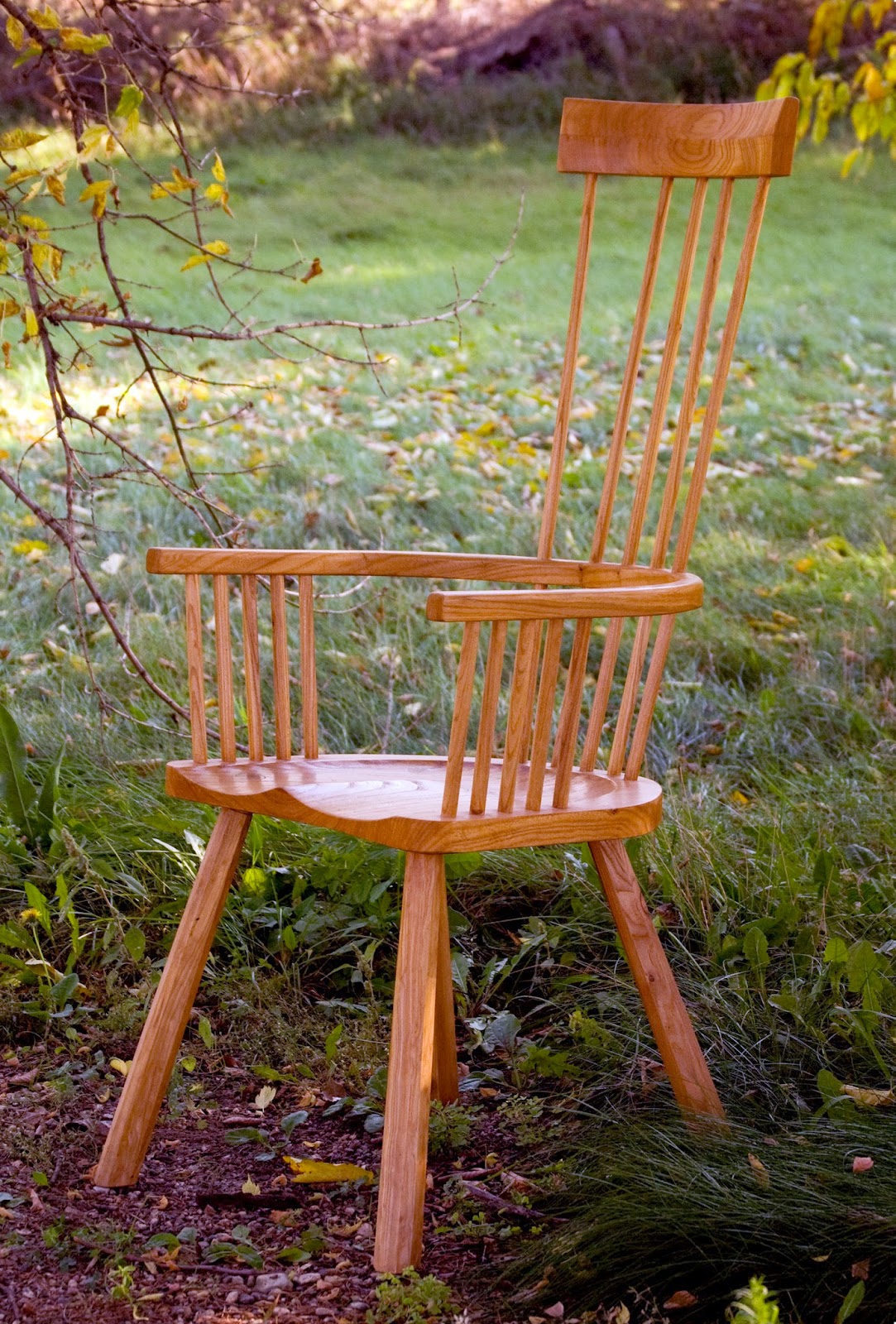Chairs, Welsh stick #1, #2, #3.
Quoting myself from April, "The first seat was almost finished today...". Hmm, almost is a long time. Here is the first Chair, fitted out with chair seat number two. Five spindles, elm legs and several coats of amber shellac preceding the traditional American finish of spar varnish, turpentine and linseed oil. The mistakes cannot be seen; though I will point out the two outside spindles. The flare out only by accident, though we like the effect. The top piece, the comb comes from one piece, resawn, glued together and shaped with spokeshave and draw knife. The curved arm is one piece of steam bent elm. They are very, very comfortable.
 |
Chair the 1st
|
 |
Chair #1
|
The same chair from the left side. The curve at the back of the seat is the section of a circle. The five short spindles are 5/8" in diameter, and the arm is 10.25 inches above the seat. The long spindles taper from 5/8" in the seat to 1/2" in the comb. The various flaws and difficulties in the bent arm do no show in this photo. We are very happy with the flare of the legs. Like the stools, the seat is 18-18 1/2 inches above the ground/floor. And like the stools, the seats are undercut at 15 degrees to create a thinner appearance. The front of the seat is 1 1/2" higher than the rear. This tilt, and the shaping of the elm seat account for the great ease sitting in these chairs. (Thank you Welshman John Brown, Requiescat in pace.)
 |
Chair the 2nd
|
The first seat made lives on the second chair. Many changes, seven spindles, and the legs angled slightly differently . Though elm does not split, during steam bending it tend to separate at the tiniest pin knots. We lost four of six on the first attempt. (I will have steam box photos eventually, in the next six months or so...heh.) Consequently, I have been making the arm from three pieces of steam bent elm, 1 1/4" x 7/16" x 54". All three pieces are bent on the form simultaneously and later glued up with Titebond II. Many problems are thus solved with this technique, and the appearance is quite good. (The lamination is not apparent to the unschooled eye.) The top comb is made the same way; here with three pieces of 5/16" x 4" x 18". (I start with 24" lengths for the comb and cut the excess after steam bending. It is very difficult to bend several short, wide pieces. Mostly the combs come from the quarter-sawn elm. See the photos from April 23, with the house in the background. Those clean edges are the quarter-sawn stuff.)
 |
Chair the 2nd
|
There is a bit less direct light in this photo; the true color is above. Again some amber shellac has been applied before the spar varnish blend. Here there are seven long spindles, on 2 inch centers, so wider apart than Chair the 1st. And with no shot of the seat, the beautiful pattern therein cannot be seen, sorry. However, the troubles I had with aligning the holes cannot be seen either. (There are some 14 oops plugs on this one. Curiously enough, the unschooled eyes don't notice them either.)
Chair #3 has eight spindles, and ash legs. (Ash in this part of the world is Pennsylvania green ash, and not northern white ash. It has brown heartwood, subject to rot. After Siberian elm, the green ash is the next most populous tree in the windbreaks, followed by cedar, and honey locust and lots of lilac.) We hope to make ash seats someday. There is not shellac on this chair, just the elm's natural color. We think it's like pale dry autumn grasses. With shellac, the color resembles the state grass or South Dakota, Pascopyrum smithii ,western wheat grass.
 |
#3
|
The front view shows the eight long spindles a bit more clearly. And yes, there is a bit of twist on the arm, right side if sitting down, left side as seen here. The problem has been solved in the next chair with better clamping technique. Steam bent and laminated arm and comb again.
 |
#3
|






Kerry these chairs look wonderful you are very talented. Regards from Harry Rogers
ReplyDelete